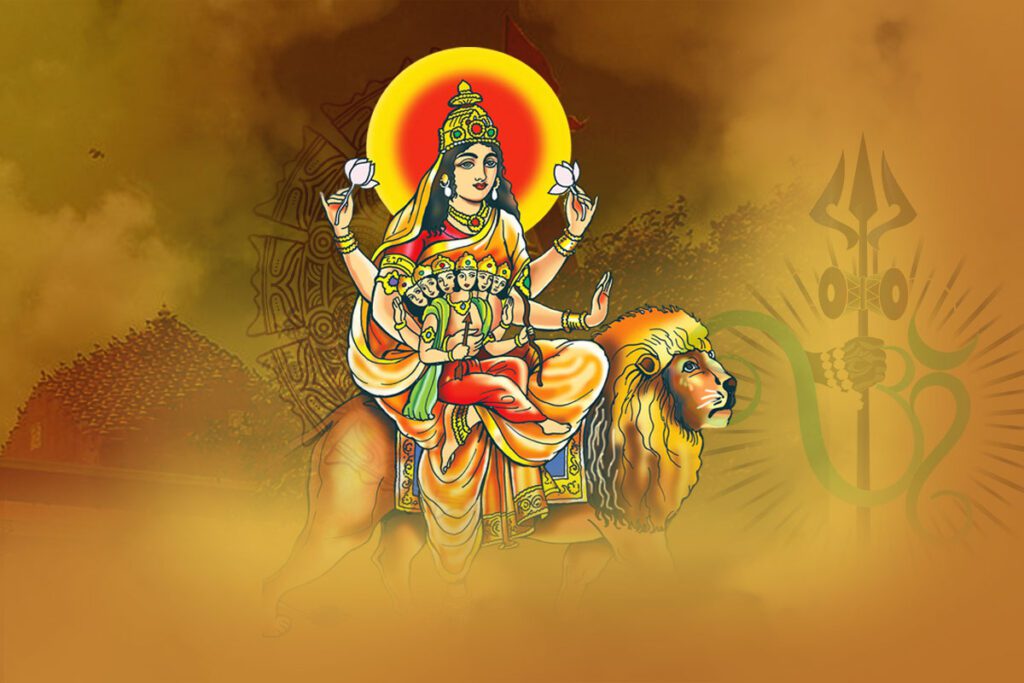Introduction to Skandamata
Skandamata, the fifth manifestation of Navadurga, is worshipped on the fifth day of Navratri. Her name is derived from two Sanskrit words: Skanda (another name for Lord Kartikeya) and Mata (mother), signifying her role as the mother of Skanda, the commander of the divine army.
She embodies motherly compassion, nurturing strength, and divine wisdom, offering protection and blessings to her devotees. Worshipping Skandamata during Navratri is believed to bring peace, prosperity, and spiritual elevation.
Mythological Background
Origin and Connection to Lord Skanda
Skandamata is the motherly form of Goddess Parvati, who gave birth to Lord Skanda (Kartikeya) to defeat the demon Tarakasura. According to Hindu mythology:
- Tarakasura received a boon that only Shiva’s son could kill him.
- Parvati performed intense penance to marry Shiva.
- Their union led to the birth of Skanda, who was raised by the Krittika Devis and later by Parvati herself as Skandamata.
- Skanda became the commander-in-chief of the Devas, defeating Tarakasura and restoring cosmic balance.
Scriptural Mentions
Skandamata is mentioned in various Puranas, including the Devi Bhagavatam and Skanda Purana, where she is praised for her maternal strength, wisdom, and divine grace.
Appearance and Symbolism
Skandamata’s iconography is rich with spiritual symbolism:
| Element | Symbolism |
|---|---|
| Four Arms | Represents her divine powers and protection |
| Lotus Flowers | Symbolize purity, wisdom, and spiritual awakening |
| Lord Skanda in Lap | Embodies nurturing motherhood and divine guidance |
| Lion as Vahana | Denotes courage and fierce protection |
| Abhaya Mudra | Gesture of fearlessness and assurance to devotees |
| White or Yellow Attire | Signifies purity, peace, and serenity |
She is also known as Padmasana Devi, often depicted seated on a lotus, radiating calm and divine grace.
Spiritual Significance
Skandamata governs the Vishuddha Chakra (Throat Chakra), which influences:
- Communication and expression
- Purity of thoughts and speech
- Wisdom and spiritual clarity
Blessings of Skandamata
Devotees worship Skandamata to receive:
- Wisdom and intellect
- Protection from evil
- Maternal blessings for children
- Spiritual growth and inner peace
Her worship is especially beneficial for those seeking mental clarity, emotional healing, and family harmony.
Navratri Day 5: Rituals, Prayers, and Offerings
Puja Vidhi (Worship Procedure)
- Cleanse the space and wear white or yellow attire.
- Place an idol or image of Skandamata on a decorated altar.
- Offer white flowers, bananas, and kheer (rice pudding).
- Light incense and ghee lamps.
- Chant Skandamata mantras and perform aarti.
- Meditate and seek her blessings for wisdom and protection.
Bhog Offerings
- Bananas – Symbolize nourishment and simplicity.
- Kheer – Represents purity and sweetness.
- Dry fruits and coconut ladoos – Offered for prosperity.
Color of the Day
White is the color associated with Skandamata, representing peace, purity, and spiritual calmness.
Mantras and Hymns
Chanting Skandamata mantras invokes her divine energy. Popular mantras include:
Beej Mantra
ॐ देवी स्कन्दमातायै नमः
Om Devi Skandamatayai Namah
Dhyan Mantra
या देवी सर्वभूतेषु माँ स्कंदमाता रूपेण संस्थिता।
नमस्तस्यै नमस्तस्यै नमस्तस्यै नमो नमः॥
Stotra Verse
वन्दे वाञ्छित कामार्थे चन्द्रार्धकृत शेखराम।
सिंहारूढा चतुर्भुजा स्कन्दमाता यशस्विनीम्॥
These mantras are often chanted 108 times during puja to deepen spiritual connection and receive blessings.
Legends and Stories
One of the most revered legends is the battle against Tarakasura:
- Skandamata nurtured and trained Skanda to become a divine warrior.
- Her maternal guidance was instrumental in Skanda’s victory.
- She symbolizes the power of motherhood that shapes destiny and protects dharma.
Other stories highlight her role in guiding devotees through spiritual trials, offering wisdom and courage.
Festivals and Celebrations Across India
Skandamata’s worship on Navratri Day 5 is celebrated with regional variations:
Gujarat
- Devotees perform Garba and Dandiya Raas in her honor.
- Temples are adorned with white flowers and lights.
West Bengal
- Integrated into Durga Puja, with elaborate idols and cultural programs.
Tamil Nadu
- Golu displays feature Skandamata among other deities.
- Families gather to chant mantras and share prasad.
North India
- Fasting and Durga Saptashati recitations are common.
- Community pujas and bhajan evenings are held.
These celebrations reflect her universal appeal and the diverse devotional practices across India.
Benefits of Worshipping Skandamata
Worshipping Skandamata brings a multitude of blessings:
Mental and Spiritual
- Clarity of thought
- Wisdom and knowledge
- Emotional healing
Protective
- Shield from negativity
- Courage to face challenges
- Guidance in difficult times
Material
- Prosperity and abundance
- Harmony in family life
- Fulfillment of desires
Her blessings are said to transform ignorance into wisdom, and fear into strength.
Conclusion: Skandamata’s Relevance in Modern Spiritual Practice
In today’s fast-paced world, Skandamata’s nurturing energy offers a sanctuary of peace and wisdom. Her worship on Navratri Day 5 reminds us of the power of motherhood, the importance of inner purity, and the strength found in compassion.
Whether seeking spiritual growth, mental clarity, or family harmony, Skandamata’s divine presence continues to guide devotees toward light, love, and liberation.

